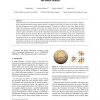Free Online Productivity Tools
i2Speak
i2Symbol
i2OCR
iTex2Img
iWeb2Print
iWeb2Shot
i2Type
iPdf2Split
iPdf2Merge
i2Bopomofo
i2Arabic
i2Style
i2Image
i2PDF
iLatex2Rtf
Sci2ools
CGF
2010
2010
Invisible Seams
Surface materials are commonly described by attributes stored in textures (for instance, color, normal, or displacement). Interpolation during texture lookup provides a continuous value field everywhere on the surface, except at the chart boundaries where visible discontinuities appear. We propose a solution to make these seams invisible, while still outputting a standard texture atlas. Our method relies on recent advances in quad remeshing using global parameterization to produce a set of texture coordinates aligning texel grids across chart boundaries. This property makes it possible to ensure that the interpolated value fields on both sides of a chart boundary precisely match, making all seams invisible. However, this requirement on the uv coordinates needs to be complemented by a set of constraints on the colors stored in the texels. We propose an algorithm solving for all the necessary constraints between texel values, including through different magnification modes (nearest, bil...
| Added | 09 Dec 2010 |
| Updated | 09 Dec 2010 |
| Type | Journal |
| Year | 2010 |
| Where | CGF |
| Authors | Nicolas Ray, Vincent Nivoliers, Sylvain Lefebvre, Bruno Lévy |
Comments (0)

